Xjet Opens Additive Manufacturing Center Gives Details on Nanoparticle Jetting 3D Printing We Interview CEO Hanan Gothait
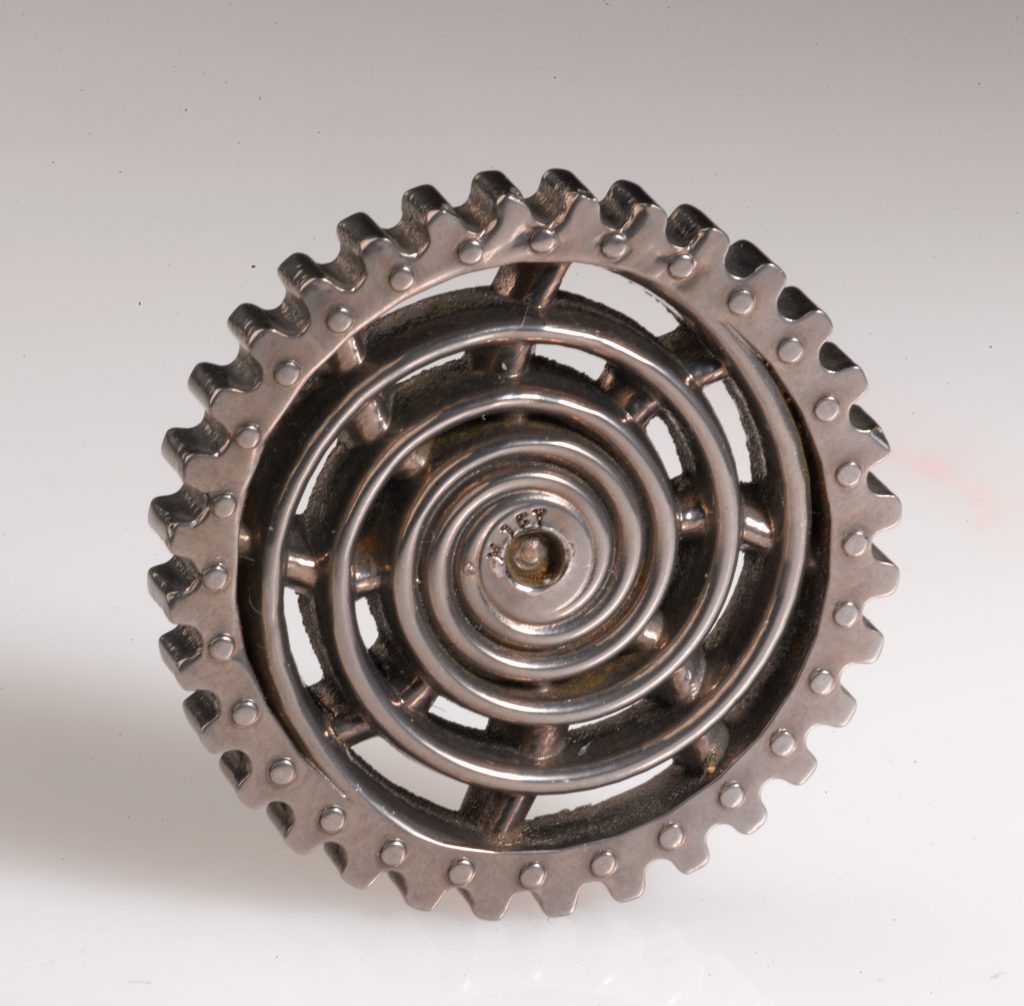
316L Stainless Steel part
A number of journalists and partners have been taken on a whirlwind tour of Israel by Xjet. The ceramics and metal printing company wanted to show us their homeland as well as their new Carmel 1400 AM System and the opening of their Additive Manufacturing Center was the occasion. We stay in Tel Aviv amidst gleaming towers, bustling sidewalk cafes, markets and an impossible number of young people zooming by on electric scooters. A passionate tour guide extols the virtues of the land and her people as our bus drives to Rehovot.
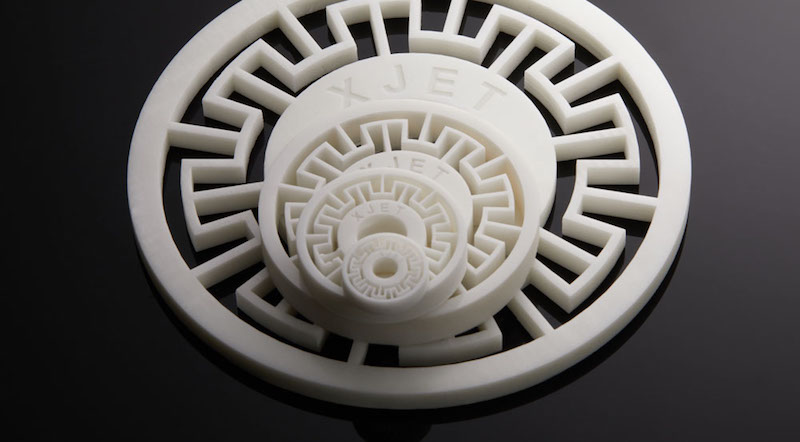
3D Printed Xjet Ceramics
The Carmel 1400 has a 500 by 140 by 200 mm build volume, 10 to 15 micron layer thickness and ways two and three-quarter tonnes. That’s almost two Toyotas. The printer is capable of printing zirconia parts with features of a 100 microns at 1 mm per hour build speed at a part density of 99.95%. The Zirconia Zr02 comes with a support material that let one have a high degree of geometric freedom with this technical ceramic. Part shrinkage is uniform in every direction and predictable. Another new material is Stainless Steel, 316L. Both support and build material are supplied in cartridges in a liquid suspension form.
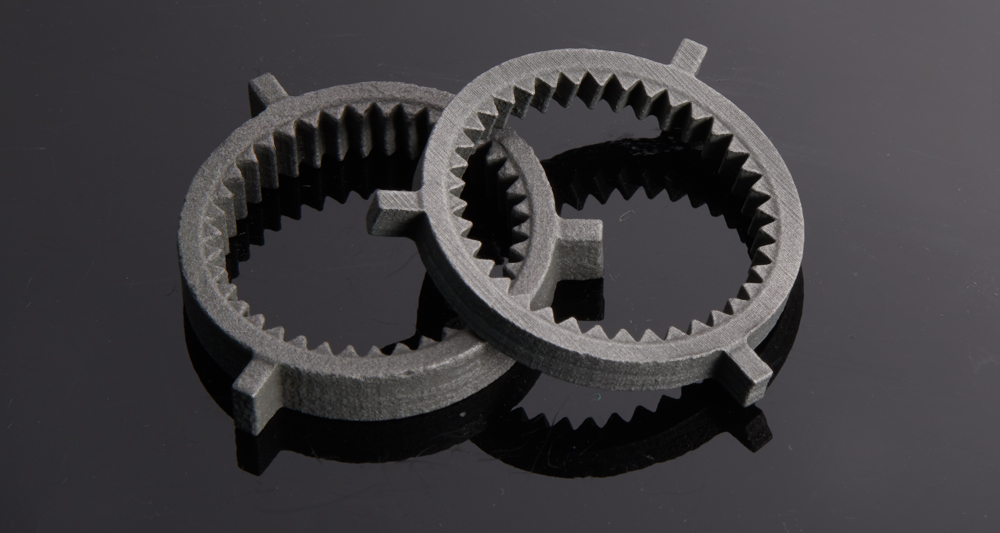
316L Stainless Steel parts no post-processing apart from support removal and sintering.
Xjet’s technology NanoParticle Jetting has been designed as an inkjet-based technology to make parts at high volume and througput. The nanoparticle build material is then jetted with both support and build material to be jetted simultaneously. The liquid suspension that contains the nanoparticles then evaporates due to a heated chamber. Then parts are sintered, and support is removed. Support is soluble and is dissolved in a solvent bath.
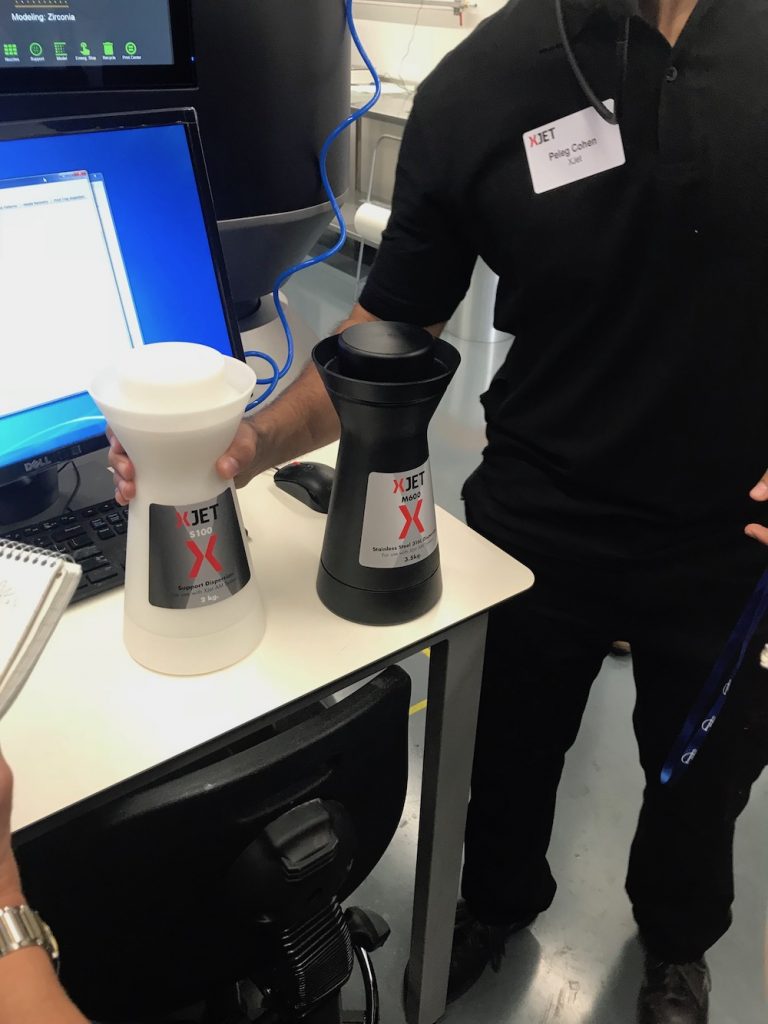
Xjet’s Material Cartridges
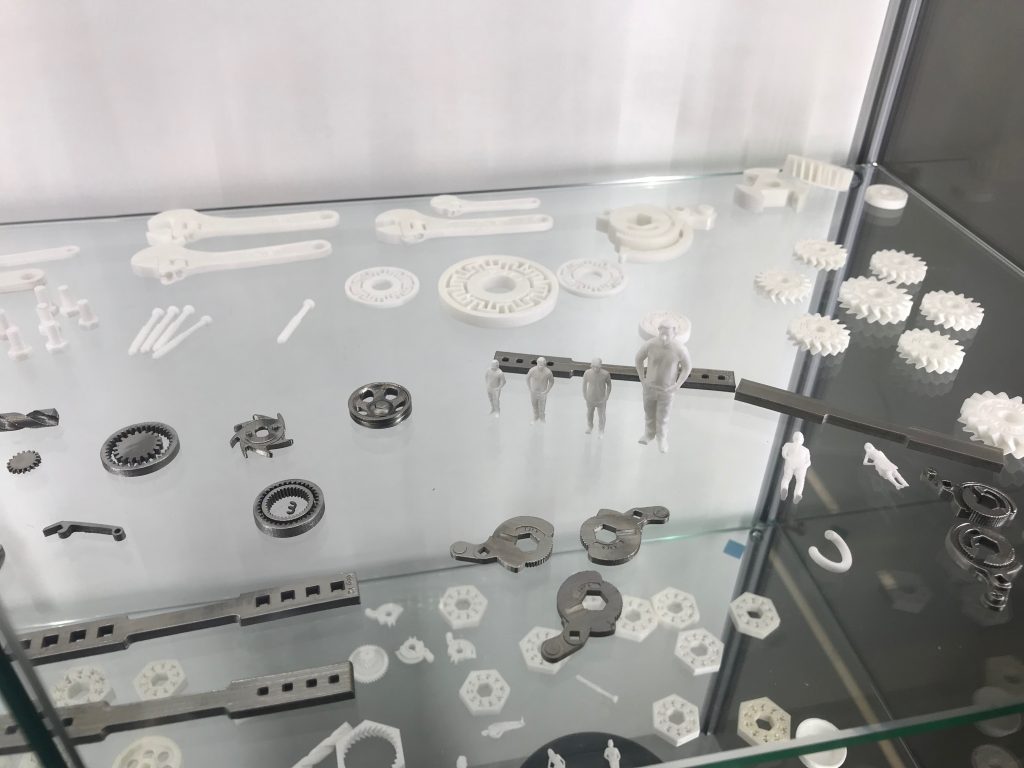
Various 3D Printed Xjet Parts
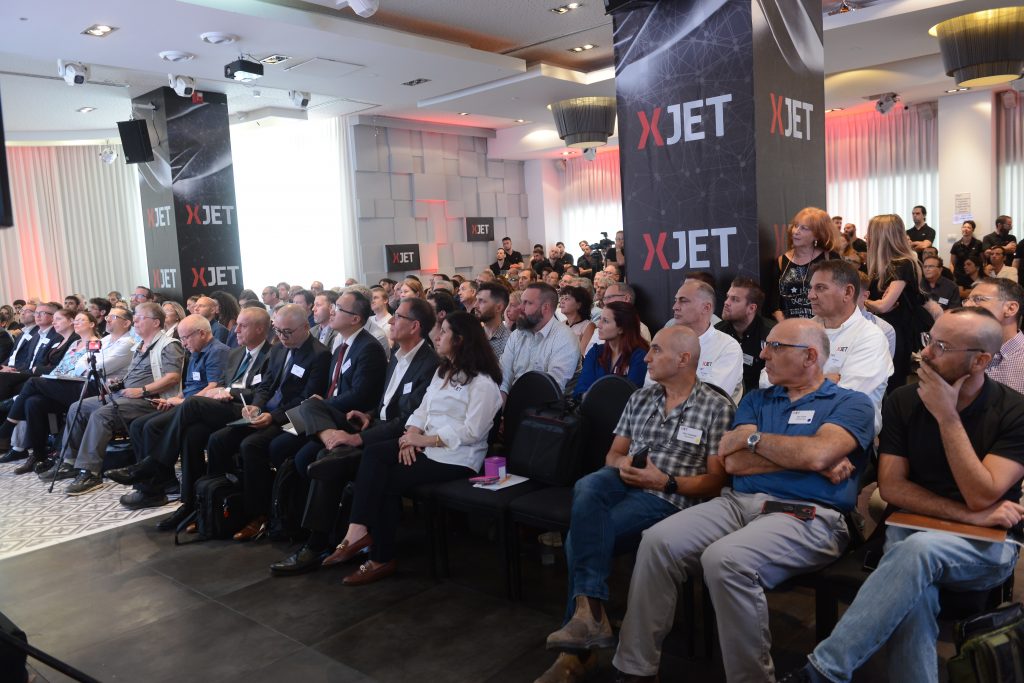
The crowd at the speeches.
Xjet is a product of a number of industry veterans in inkjet, some of whom played pioneering roles in creating Objet Polyjet, the Stratasys inkjet technology. The team and the machine are impressive as well. Their ambition complements this with a sated claim to move into metals and ceramics printing for production. Ceramics 3D printing so far has been limited in build volume and throughput. You could print technical ceramics but could not make thousands of Zirconium parts per day.
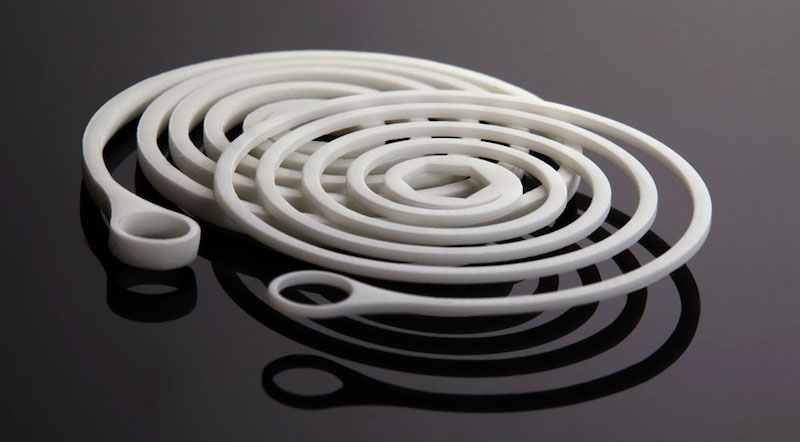
This is precisely what companies want to do with the materials, however. Extremely high wear parts with extremely high-temperature and abrasion resistance are used widely in industry. Nozzles, high wear machinery surfaces, medical components, teeth, and other dental replacements are all candidates for Zirconium parts. As for stainless steel, that application area is much much broader, but that would have to be determined at a later date. The stainless materials would depend much more on the cost to be viable. There are also several metal printing technologies that could make them.

We are lead into a meeting room and listened to some presentations. Xjet founder Hanan Gothait told us to “enjoy the future of 3D metal and ceramics.” He was proud of the Xjet team completed the project on time and on budget. He also said that “Additive Manufacturing is moving from theory to real, ideas to products, prototypes to real parts.” He also mentioned that “the metal 3D printing, “market is boiling, and we are ready to deliver.” Next Professor Oded Shoseyov gave a presentation detailing his attempts to make a collagen replacement through getting tobacco plants to grow collagen using expressions of five human genes. He is also working on Nanocellulose as a biological additive with a wide array of applications in material science. Perry Davidson the CEO of SyQue an innovative metered dose marijuana and other botanicals inhaler then took us on a fascinating journey to see how their company used 3D printing. Mr. Andreas Berkau of engineering company Oerlikon then explained to us that “Xjet is a truly disruptive technology” and that the future of 3D printing is in “closed value chains” that have “systems beginning to end” and have “whole ecosystems for additive manufacturing.” Dror Danai Xjet’s Chief Business Officer then went on to also talk how important the Xjet team is while decrying the powder bed fusion systems. Dror believes that liquids can provide much better results than traditional powder bed systems. He mentions that powder bed fusion parts are typically limited to 50 micron parts while in the lab Xjet has printed 10 nanometer particles. He stated that the “Digital manufacturing dream vanishes” with post-processing. Manual post-processing slows part production and increases costs significantly. With Xjet’s easier post-processing using soluble support parts will be a fit for manufacturing.

Xjet CEO Hanan and Formnext VP Sacha Wenzler
We then as a group of over a hundred descend to wait before the Xjet Application center. Sacha Wenzler of Formnext opens it. Once open we can find operational Carmel 1400 Xjet systems. We are shown highly accurate and very smooth metal and ceramics parts as well as the support removal process. The machines look very complicated indeed. They hum and with a swoosh deposit every new layer from two mixing jars, one for support and one for build material. The machines are big beasts of things and dutifully lay down each layer in turn.
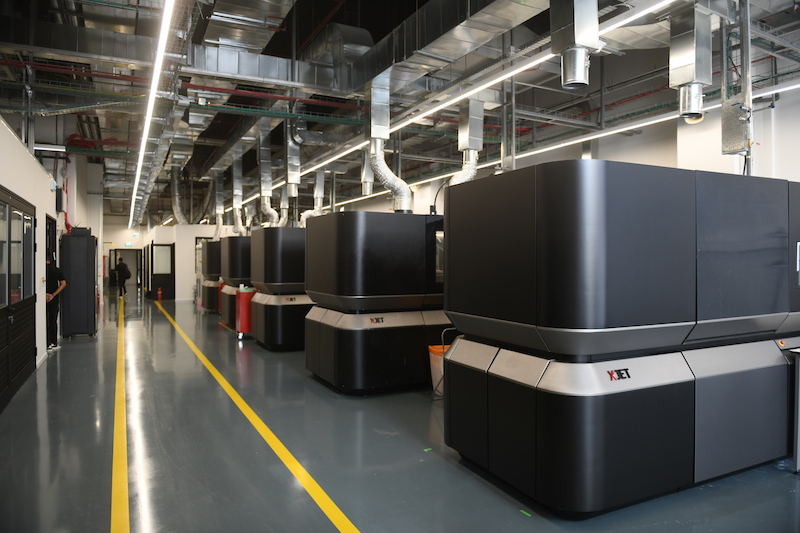
The Xjet Additive Manufacturing Center
Later on, we will go on to see where the Xjet systems are assembled. There whale carcasses lie of machines that will be made as well as nearly finished systems for Oerlikon, Carfulan and the University of Delaware. Larry Holmes of the University of Delaware poses for the machine his university will receive. Then we head off with dervish-like speed for a tour of Jerusalem. All in all, it was a lovely trip and an excellent chance to have a lot of in-depth contact with the Xjet team. The team are all very open and responded to in-depth technical questions with deep understanding.
3DPrint.com got the chance to interview Xjet CEO and founder Hanan Gothait. He told us that
“The significance of Xjet is that is is a new and innovative powderless nanoparticle inkjet technology which is safe, easy to use and gives you totally accurate parts with smooth surfaces. Everyone is using 50 micron layer thickness and we are using 7 micron layers which leads to better surface quality. In addition we have fine features that no one else can do. Support material is also a different material which can be removed by immersing the part in water. This dissolvable support means that you can make more complex geometries in metal. The big breakthrough is to make 3D printing for ceramics and metals safe and simple while making support easy to remove.”
He also stated that,
“The fine particles we use also create high-resolution parts while simplicity means that you don’t need to be a Ph.D. to operate the machine.”
and that,
“Medical devices, dental, industrial companies, automotive and aerospace companies are already customers. We want to partner with customers and help them grow.”
Hanan has a multi-decade in 3D printing starting with his founding of Objet, now a Stratasys unit. Since then..
“In the Objet days no one spoke of manufacturing, the dream was to become a prototype supplier. Still today most of the market is prototyping but we are targeting production now and we see ourselves as one of the leaders.”
This is a company steeped in inkjet and 3D printing. Compared to a lot of US-based startups this company has many people with ten of twenty years experience in 3D printing. Dozens more have decades of experience in inkjet. As we pass by the Intel Fab and large HP Indigo buildings where printers and inks are made we can see that near the Xjet assembly location there is a vast inkjet ecosystem. Sitting in the middle of this ecosystem, Xjet has access to a very deep and very experienced talent pool of people. Where a US based start usually throws a bunch of very bright kids at the problem, Xjet has dozens of employees who have seen this problem before and also has the bright kids as well. Especially the deep involvement with originating the Polyjet technology is a massive plus for the Xjet team. At one point Objet was nearly dead because an engineering team had not managed to turn a slick idea into a working machine and software combination. Resolute management steps and a re-engineering of the system brought the easiest to use and slickest software, materials and machine combo of the day. This kind of sophisticated engineering approach and the skills needed for it are vital to producing high-quality 3D printers. It is easy to make 3D printers and very difficult to make good 3D printers. By understanding the need to know how the complex interplay of software settings and materials interact to form the part high-quality machines can be crafted. It is not the highly detailed parts or the engineering in the machine that inspires confidence but rather the paths that the team has taken to get here. By focusing on ceramics and trying to create a highly productive solution to manufacture them Xjet has taken an interesting turn towards the future of 3D printing. A segway to metal parts could also deliver a lot of value to customers as could an investment in BMG’s or 3D printed circuits. For now, 3D printing ceramics at volume is a tremendous opportunity. If done well this is precisely the kind of technology and part that could widely expand the scope of the possible in 3D printing and Xjet may just be the company to make that happen.
3D Printing News Briefs: October 13, 2018
We’ve got business and education news galore in today’s 3D Printing News Briefs. First, Voodoo Manufacturing has launched its new Shopify app, and BeAM Machines is partnering with Empa, while Sculpteo is working with a property developer to provide 3D printed apartment models. VSHAPER has signed an agreement with educational publisher Grupa MAC, and the United Arab Emirates is introducing 3D printing into over 200 of its primary schools. The US Navy will be testing the first 3D printed ship component, and Lufthansa Technik has established a new Additive Manufacturing Center. Finally, maker Thomas Sanladerer shared on YouTube about his recent visit to the Prusa headquarters.
Voodoo Manufacturing Launches Shopify App
 This spring, high-volume 3D printing factory Voodoo Manufacturing began its full-stack manufacturing and fulfillment service for 3D printing entrepreneurs, which allows users to outsource work like quality control and assembly for their products through its easy shopfront integrations with online marketplaces like Shopify. Now, the company has launched its own Shopify app, which will allow online sellers to create and customize 3D printed products and sell them on their own Shopify stores. Once the app is installed, users can make their first product in less than 5 minutes, which is then automatically added to their store, ready for purchase.
This spring, high-volume 3D printing factory Voodoo Manufacturing began its full-stack manufacturing and fulfillment service for 3D printing entrepreneurs, which allows users to outsource work like quality control and assembly for their products through its easy shopfront integrations with online marketplaces like Shopify. Now, the company has launched its own Shopify app, which will allow online sellers to create and customize 3D printed products and sell them on their own Shopify stores. Once the app is installed, users can make their first product in less than 5 minutes, which is then automatically added to their store, ready for purchase.
“We wanted to make it ridiculously easy for ecommerce stores to diversify their product offering with 3D printed products. By applying 3D printing to the print-on-demand business model, we are opening up an infinite range of product categories for Shopify merchants,” said Max Friefeld, the Founder and CEO of Voodoo Manufacturing. “The Voodoo app provides a new source of high quality, customizable, on-demand products, that don’t require any 3D design experience.”
Before the official launch this week, Voodoo piloted the service with a group of beta users, including It’s The Island Life by graphic designer and Guam native Lucy Hutcheson. She is already successfully selling six different products made with the help of the new Voodoo app.
BeAM Machines Partnering with Empa
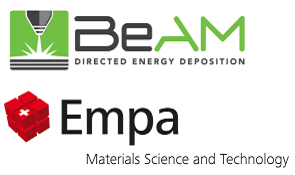 BeAM, recently acquired by AddUp, has signed a research and development agreement with Empa, the Swiss Federal Laboratories for Materials Science and Technology. Together, the two will develop novel applications for BeAM’s powder-based Directed Energy Deposition (DED) technology, which uses focused thermal energy to fuse materials by melting them while they’re deposited. This makes parts manufacturing much faster. The partnership has come on the heels of Empa’s acquisition of a BeAM DED 3D printer, which is located at its Laboratory for Advanced Materials Processing in Thun and is used to integrate and test out innovative components.
BeAM, recently acquired by AddUp, has signed a research and development agreement with Empa, the Swiss Federal Laboratories for Materials Science and Technology. Together, the two will develop novel applications for BeAM’s powder-based Directed Energy Deposition (DED) technology, which uses focused thermal energy to fuse materials by melting them while they’re deposited. This makes parts manufacturing much faster. The partnership has come on the heels of Empa’s acquisition of a BeAM DED 3D printer, which is located at its Laboratory for Advanced Materials Processing in Thun and is used to integrate and test out innovative components.
Patrik Hoffmann, who leads the laboratory, said, “We are very excited to collaborate with BeAM’s engineers to push the boundaries of this innovative additive manufacturing technology and to develop a whole new range of applications for Swiss industries and beyond.”
Sculpteo 3D Printing Apartment Models
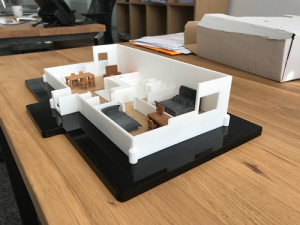 Together with Sculpteo, French property developer Valoptim is working to improve customer experience by providing clients with miniaturized 3D printed models of their future apartments when they sign their contracts, so they can better visualize and prepare for moving into their new home. These small, exact replicas give new owners an immersive experience, which is a definite value add. In addition, production of the 3D printed models is local, and can be done fast.
Together with Sculpteo, French property developer Valoptim is working to improve customer experience by providing clients with miniaturized 3D printed models of their future apartments when they sign their contracts, so they can better visualize and prepare for moving into their new home. These small, exact replicas give new owners an immersive experience, which is a definite value add. In addition, production of the 3D printed models is local, and can be done fast.
“Sculpteo uses the best machines and 3D printing processes on the market today. At first, we had the ambition to test the feasibility of 3D printing in the real estate sector. This innovative process has proven to be extremely interesting: the realistic rendering, with high-end finishes, allowed our clients to discover a miniaturized version of their future apartment enabling them to realistically imagine themselves living in it,” said Edouard Pellerin, CEO of Valoptim. “This innovation contributes to our business dynamic: constantly improving the customer experience.”
VSHAPER and Grupa Mac Sign Agreement
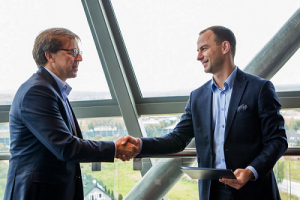 Polish 3D printer manufacturer Verashape has signed an agreement with Grupa MAC, the country’s top educational publisher, in front of Poland’s education curators at the recent Future of Education Congress. Per the agreement, Grupa MAC will use a network of educational consultants to distribute the VSHAPER GO 3D printers to kindergartens and other schools in the country. Grupa MAC recognizes that 3D printers are a good way to quickly present the effects of students’ learning, and the VSHAPER GO is the perfect choice, as it is easy to use and comes with an intuitive interface of SOFTSHAPER software.
Polish 3D printer manufacturer Verashape has signed an agreement with Grupa MAC, the country’s top educational publisher, in front of Poland’s education curators at the recent Future of Education Congress. Per the agreement, Grupa MAC will use a network of educational consultants to distribute the VSHAPER GO 3D printers to kindergartens and other schools in the country. Grupa MAC recognizes that 3D printers are a good way to quickly present the effects of students’ learning, and the VSHAPER GO is the perfect choice, as it is easy to use and comes with an intuitive interface of SOFTSHAPER software.
“Classes with students are a perfect environment for the use of 3D Printing. Creating a pyramid model for history lessons, the structure of a flower or a human body for biology lessons are just a few examples, and their list is limited only by the imagination of students and teachers,” said Patryk Tomczyk, a member of the Grupa MAC Management Board. “We are happy that thanks to our cooperation with VERASHAPE, 3D Printers have a chance to reach schools through our network of educational consultants.”
3D Printing to be Introduced in UAE Primary Schools
 Speaking of 3D printing in education, the Ministry of Education (MoE) for the UAE has announced that in early 2019, a country-wide introduction of 3D printing into over 200 primary schools will commence. As part of this new technology roll out, Dubai education consultancy company Ibtikar is partnering with Makers Empire, an Australian education technology company, to deliver a program that implements 3D printing and design. Makers Empire will supply 3D software, curriculum, teacher resources, training, and support to Ibtikar, which will in turn train MoE teachers to deliver the program.
Speaking of 3D printing in education, the Ministry of Education (MoE) for the UAE has announced that in early 2019, a country-wide introduction of 3D printing into over 200 primary schools will commence. As part of this new technology roll out, Dubai education consultancy company Ibtikar is partnering with Makers Empire, an Australian education technology company, to deliver a program that implements 3D printing and design. Makers Empire will supply 3D software, curriculum, teacher resources, training, and support to Ibtikar, which will in turn train MoE teachers to deliver the program.
“Through this rollout of 3D technology, our students will learn to reframe needs as actionable statements and to create solutions to real-world problems,” said HE Eng. Abdul Rahman of the United Arab Emirates Ministry of Education. “In doing so, our students will develop an important growth mindset, the skills they need to make their world better and the essential ability to persist when encountering setbacks.”
US Navy Approves Test of First 3D Printed Shipboard Part
The US military has long explored the use of 3D printing to lower costs and increase the availability of spare parts. Huntington Ingalls Industries, the largest military shipbuilder in the US, has also been piloting new technologies, like 3D printing, as part of its digital transformation. In collaboration with the US Navy, the company’s Newport News Shipbuilding division has worked to speed the adoption of 3D printed metal components for nuclear-powered warships. This has led to an exciting announcement by the Naval Sea Systems Command (NAVSEA): a metal drain strainer orifice (DSO) prototype has officially been approved as the first 3D printed metal part to be installed on a US Navy ship. The assembly is a component for the steam system, which allows for drainage and removal of water from a steam line while in use. The 3D printed DSO prototype will be installed on the USS Harry S. Truman in 2019 for evaluation and tests. After one year, the assembly will be removed for inspection and analysis.
“This install marks a significant advancement in the Navy’s ability to make parts on demand and combine NAVSEA’s strategic goal of on-time delivery of ships and submarines while maintaining a culture of affordability. By targeting CVN 75 [USS Harry S. Truman], this allows us to get test results faster, so-if successful-we can identify additional uses of additive manufacturing for the fleet,” said Rear Adm. Lorin Selby, NAVSEA Chief Engineer and Deputy Commander for Ship Design, Integration, and Naval Engineering.
Lufthansa Technik Opens New Additive Manufacturing Center
 Lufthansa Technik, a leading provider of maintenance, repair and overhaul (MRO) for civil aircraft, has established a new Additive Manufacturing Center. The goal of the new AM Center is to bundle and expand the company’s experience and competence with the technology, which can be used to make individual parts more quickly and with more design freedom. As the world of aircraft is always aware of weight, making more lightweight parts is an excellent benefit of 3D printing.
Lufthansa Technik, a leading provider of maintenance, repair and overhaul (MRO) for civil aircraft, has established a new Additive Manufacturing Center. The goal of the new AM Center is to bundle and expand the company’s experience and competence with the technology, which can be used to make individual parts more quickly and with more design freedom. As the world of aircraft is always aware of weight, making more lightweight parts is an excellent benefit of 3D printing.
“The new AM Center will serve as a collaborative hub where the experience and skills that Lufthansa Technik has gained in additive manufacturing can be bundled and further expanded,” said Dr. Aenne Koester, the head of the new AM Center. “The aim is to increase the degree of maturity of the technologies and to develop products that are suitable for production.”
Tom’s 3D Visits Prusa Headquarters
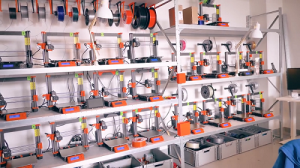 Maker Thomas Sanladerer, who runs his own YouTube channel, recently had the chance to tour the Prusa Research headquarters in Prague. Not only did he get the opportunity to see how the company makes its popular MK3 and and MK2.5, but Sanladerer was also able to see early models of the company’s recently announced SL1 resin 3D printer, as well as the Prusament filament production line.
Maker Thomas Sanladerer, who runs his own YouTube channel, recently had the chance to tour the Prusa Research headquarters in Prague. Not only did he get the opportunity to see how the company makes its popular MK3 and and MK2.5, but Sanladerer was also able to see early models of the company’s recently announced SL1 resin 3D printer, as well as the Prusament filament production line.
“I always find factory tours like this super interesting because it’s the only chance you really get of seeing behind the scenes of what might really just be a website, or you know, a marketing video or whatever,” Sanladerer said in his video.
Sanladerer took the tour of the Prusa factory right after Maker Faire Prague, which the company itself organized and sponsored. To see behind the scenes of Prusa for yourself, check out the rest of the video below:
Discuss these stories and other 3D printing topics at 3DPrintBoard.com or share your thoughts below.

